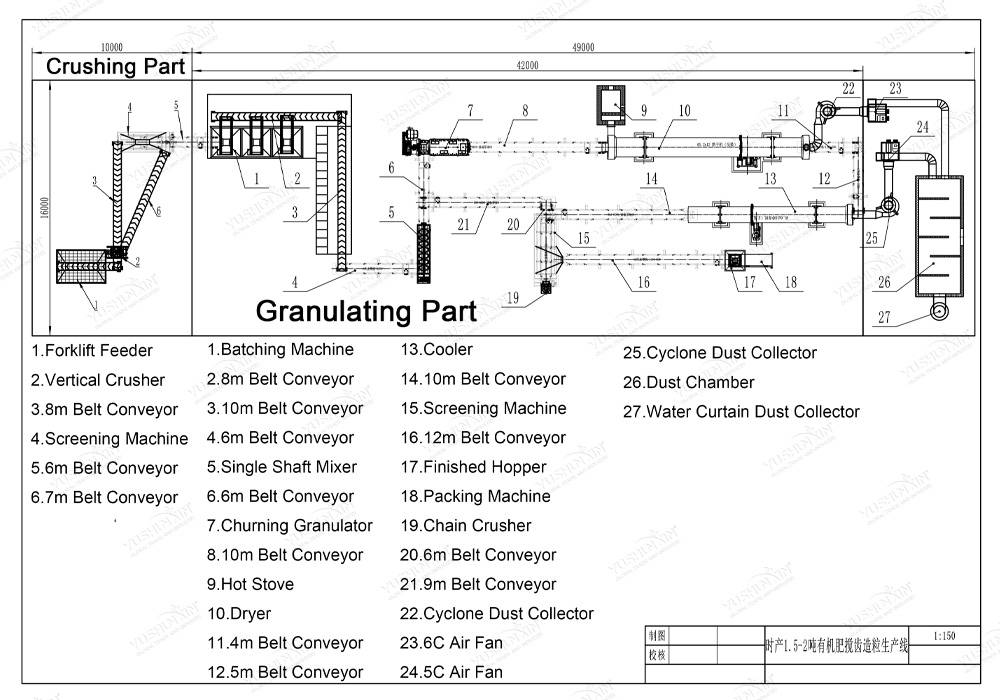







Norėdami konvertuoti fosfato uolieną į tinkamos trąšų formą, Rūgštis reikalinga “gazuotas” Rokas, kurie išskiria tirpius fosforo junginius. Paprastos rūgštys apima:
Kurti NPK trąšos, Kiti azoto ir kalio šaltiniai gali būti sumaišyti su fosfato medžiaga. Kai kurie pavyzdžiai yra:
Kiekvienos gamybos linijos kaina skiriasi priklausomai nuo gamybos pajėgumų, automatizavimo laipsnis, ir specifiniai poreikiai. Užpildykite žemiau esančią formą ir pateiksime tikslią citatą!
Jei jus domina mūsų trąšų gamybos įranga, Pateikite savo reikalavimus ir kontaktus, tada mes susisieksime su jumis po dviejų dienų. Pažadame, kad visa jūsų informacija niekam nebus nutekinta.
- Bendrovė buvo įkurta 2005 ir daugiausia dėmesio skyrė ekologiškų trąšų įrangos tyrimams ir plėtrai bei gamybai 20 metai. Jis sukūrė 40 000 m didelio masto ekologiškų trąšų įrangos gamybos bazę, Naudojant pažangų granuliaciją, Džiovinimo ir atrankos technologijos siekiant pagerinti gamybos efektyvumą ir produkto kokybę.
- Savarankiškai valdomas importo ir eksporto įmonė su daugiau nei 80 Profesionalūs inžinieriai visame pasaulyje, tarnauja daugiau nei 100 Šalys ir regionai visame pasaulyje, 5,000+ Klientų aptarnavimo atvejai, 10 Apdorojimo centrai, 3 Lazerio pjovimo mašinos, ir daugiau nei 60 Įvairių tipų įranga.
- Ilgalaikio ir plataus bendradarbiavimo su daugeliu mokslo tyrimų institutų ir universitetų palaikymas, with a professional R&D team, Tai gali nuolat optimizuoti įrangos našumą pagal rinkos paklausą.
- Didelio stiprumo susidėvėjimui atsparios medžiagos, Anglies plienas Q235/lydinys pasirenkamas siekiant užtikrinti, kad įranga būtų patvari, ir sumažinti priežiūros išlaidas.
- Priimant intelektualias valdymo sistemas, siekiant pagerinti gamybos automatizavimo lygį ir sumažinti rankinę priklausomybę.
- ISO, CE, SGS tarptautinis sertifikavimas
- Su didelio masto gamybos pajėgumais, Tai gali atitikti skirtingus gamybos pajėgumų reikalavimus (mažas, vidutinės ir didelės gamybos linijos).
- Visas įrangos modelių asortimentas, Tinka įvairių rūšių trąšų, tokių kaip organinės trąšos, Sudėtinės trąšos, Biologinės trąšos, Vandenyje tirpios trąšos, Skystos trąšos, ir tt.
- Suasmenintą dizainą galima pateikti atsižvelgiant į klientų poreikius, įskaitant gamybos pajėgumą, Svetainės išdėstymas, Aplinkos apsaugos standartai, ir tt.
- Pateikite išsamų gamybos linijos sprendimų rinkinį, įskaitant įrangos pasirinkimą, įrengimas ir paleidimas, Techninis mokymas, ir tt.

- Tiesioginis gamyklos tiekimas, mažinant tarpininko nuorodą, Ir kaina yra konkurencingesnė.
- Įranga turi didelį energijos vartojimo efektyvumą, sumažina energijos suvartojimą, ir padeda klientams sumažinti ilgalaikes veiklos sąnaudas.
- Tiesioginis gamyklos tiekimas, mažinant tarpininko nuorodą, Ir kaina yra konkurencingesnė.
- Įranga turi didelį energijos vartojimo efektyvumą, sumažina energijos suvartojimą, ir padeda klientams sumažinti ilgalaikes veiklos sąnaudas.
Trąšų poliravimo mašinos tiekimas pirmaujančiam trąšų gamintojui Nyderlanduose
Sėkmingas 1T/H dvigubų ritinėlių granuliatorių pristatymas klientams Turkijoje ir JK
Efektyvus komposto tekinimo sprendimas, pristatytas klientui iš Filipinų
Sėkmingas diskinio granuliatoriaus pristatymas Čilės klientui trąšų gamybai
Granuliavimo efektyvumo didinimas GoodEarth grupei, Pietų Afrika